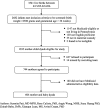Maternal and child patterns of Medicaid retention: a prospective cohort study
- PMID: 30131062
- PMCID: PMC6103876
- DOI: 10.1186/s12887-018-1242-4
Maternal and child patterns of Medicaid retention: a prospective cohort study
Abstract
Background: We sought to determine whether maternal Medicaid retention influences child Medicaid retention because caregivers play a critical role in assuring children's health access.
Methods: We conducted a longitudinal prospective cohort study of a convenience sample of 604 Medicaid-eligible mother-child dyads followed from the infant's birth through 24 months of age with parent surveys. Individual enrollment status was abstracted from administrative Medicaid eligibility files. Generalized estimating equations quantified the effect of maternal Medicaid enrollment status on child Medicaid retention, adjusting for relevant covariates. Because varying lengths of gaps may have different effects on child health outcomes, Medicaid enrollment status was further categorized by length of gap: any gap, > 14-days, and > 60-days.
Results: This cohort consists primarily of African-American (94%), unmarried mothers (88%), with a mean age of 23.2 years. In multivariable analysis, children whose mothers experienced any gaps in coverage had 12.6 times greater odds of experiencing gaps when compared to children whose mothers were continuously enrolled. Use of varying thresholds to define coverage gaps resulted in similar odds ratios (> 14-day gap = 11.8, > 60-day gap = 16.8). Cash assistance receipt and maternal knowledge of differences between Temporary Assistance to Needy Families and Medicaid eligibility criteria demonstrated strong protective effects against child Medicaid disenrollment.
Conclusions: Medicaid disenrollment remains a significant policy problem and maternal Medicaid retention patterns show strong effects on child Medicaid retention. Policymakers need to invest in effective outreach strategies, including family-friendly application processes, to reduce enrollment barriers so that all eligible families can take advantage of these coverage opportunities.
Keywords: Children; Health insurance; Medicaid retention.
Conflict of interest statement
Authors’ information
SP is Professor and Chief, Division of Primary Care Pediatrics at Stony Brook University. AC is Professor of Pediatrics at Georgetown University, Children’s National Medical Center.
Ethics approval and consent to participate
This study was approved by and carried out in accordance with guidelines from the Institutional Review Boards at the University of Pennsylvania (IRB# 802413), The Children’s Hospital of Philadelphia (IRB# 07–004091), and Stony Brook University (IRB # 2010–1250). All subjects included in this study provided informed consent (i.e. written informed consent from study participants and, for children, written informed consent from the parent/guardian for the child) in accordance with guidelines from the aforementioned Institutional Review Boards.
Consent for publication
Not applicable.
Competing interests
The authors declare that they have no competing interests.
Publisher’s Note
Springer Nature remains neutral with regard to jurisdictional claims in published maps and institutional affiliations.
Figures


References
-
- Ku L, McTaggart P, Pervez F, Rosenbaum S. Improving Medicaid's continuity of coverage and quality of care. Washington D.C.: George Washington University; 2009.
Publication types
MeSH terms
Grants and funding
LinkOut - more resources
Full Text Sources
Other Literature Sources
Medical
Miscellaneous

